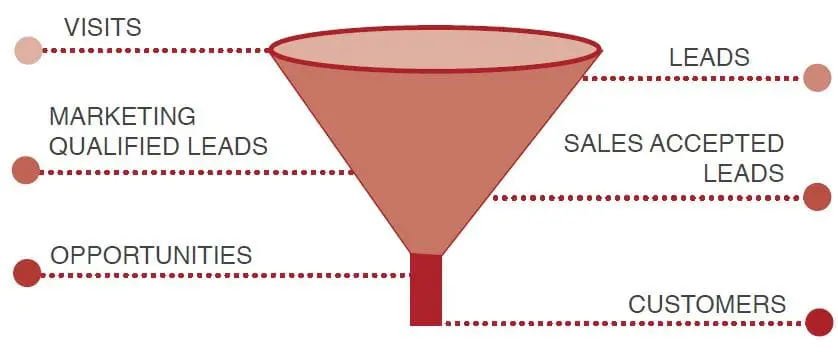Most software and technology companies struggle with the relationship between sales and marketing. Marketers think the sales team isn’t handling the sales-qualified leads that marketing provides with the alacrity and attention these leads “deserve”, and the sales team thinks that the marketers “have no idea what we do” and are disconnected with the sales process.
The mistrust and miscommunication that’s so often found between the two teams can act like an anchor on your company’s growth rate.
In fact, organizations with good alignment between sales and marketing teams achieved 20% annual revenue growth, according to a study by the Aberdeen Group. By contrast, companies with poor alignment saw revenues decline by 4%.
Creating a solid, lasting relationship between sales and marketing requires a strategic approach that treats the two teams as a single, revenue-generating organization. We call this organization the “smarketing” team to recognize the fact that sales and marketing are critical partners — not adversaries!
 The key to the Smarketing approach is implementing a framework of data-driven tools and practices that help sales and marketing teams work better together. Once hard numbers have defined key stages of your funnel and outlined each team’s expectations, there’s a lot less room for sales and marketing to argue about each other’s performance. The results are plain for everyone to see.
The key to the Smarketing approach is implementing a framework of data-driven tools and practices that help sales and marketing teams work better together. Once hard numbers have defined key stages of your funnel and outlined each team’s expectations, there’s a lot less room for sales and marketing to argue about each other’s performance. The results are plain for everyone to see.
6 key elements for successful sales and marketing alignment
Here are the key elements of a data-driven sales and marketing framework that can help you achive better collaboration between these teams and, ultimately, enhance revenue.
- Set up closed-loop reportingData is the crucial ingredient for maintaining sales and marketing alignment. You need data to monitor progress toward goals, analyze lead quality, and measure marketing ROI. So the first step in creating a Smarketing organization is establishing a closed-loop reporting system that tracks key marketing and sales metrics.The two main pieces of this system are marketing software (to help with lead generation and management) and your CRM (to track and measure sales activities). These two systems must be integrated to share data on every lead from creation to opportunity stage to close, so you can build reports that show the close rate and new customers from the leads generated by marketing.With this type of integration in place, you can trace each customer back to the source of their first visit to your website, e.g., paid search, organic search, social media or email marketing. You and also analyze each channel for other key metrics such as visits per channel, leads per channel, visit-to-lead ration per channel and lead-to-customer ratio per channel. Use this data to optimize your makerting mix and focus on the channels that are delivering the best conversion rates.
- Define your funnelTo adopt a smarketing stratgy, sales and marketing must have a unified picture of the sales funnel and standard definitionsof each stage in the process.Focus on the definition of a Marketing Qualified Lead (MQL). This is the crucial handoff point between marketing and sales, so it’s essential that the teams agree on the terminology. Every company’s definition of an MQL will vary, but it should reflect a combination of traits and actions that indicate a lead is both a good fit for your company and ready to talk to a sales person.

- Implement a service-level agreementThe service-level agreement formalizes the commitment that the sales and marketing teams make to meet shared goals for revenue growth. It’s a two-way process: The marketing team commits to delivering a certain quantity and quality of leads each month to help the sales team meet its quota. The sales team then commits to follow up on those leads in a timely manner, and to make a specific number of contact attempts before abandoning the lead.As you go about creating this agreement, remeber to use data to determine the sales team’s responsibilities. For example, how what is the ideal number of contact attempts: Even though your chances of successful connection increase each time you call a lead, those calls also have a cost associated with them: the sales rep’s time. At some point, the potential return for making
additional calls will diminish. - Monitor progress toward goalsAfter implementing the SLA, use the data from your closed-loop reporting system to track progress towards those goals. Failing to monitor progress is a common mistake made by companies with poor alignment between sales and marketing – and it can be costly. If you’re not keeping an eye on your goals, you’re less likely to spot areas of concern until they spiral into big problems. At that point it may be too late to do anything about it.
- Hold regular smarketing team meetingsRegular meetings foster communication and collaboration, and shows that you are committment to smarketing for the long term. Weekly and monthly smarketing meetings should be fast-paced, high-level overviews to keep sales and marketing teams on the same page and moving toward the SLA goals.
- Other smarketing communication
 Even with an SLA in place, and dashboards and meetings to provide regular updates, marketers still might need other ways to show the sales team how their efforts are helping achieve revenue goals.In other words, marketers should think about the sales team as another customer base, and try to“market” the role of marketing to that internal audience.As with any marketing campaign, it helps to tailor your message to the audience’s persona. In the case of the typical salesperson, that’s someone who’s super busy, doesn’t want to be distracted, doesn’t want to read long reports, and needs to know how the information you’re sharing will help them right now.
Even with an SLA in place, and dashboards and meetings to provide regular updates, marketers still might need other ways to show the sales team how their efforts are helping achieve revenue goals.In other words, marketers should think about the sales team as another customer base, and try to“market” the role of marketing to that internal audience.As with any marketing campaign, it helps to tailor your message to the audience’s persona. In the case of the typical salesperson, that’s someone who’s super busy, doesn’t want to be distracted, doesn’t want to read long reports, and needs to know how the information you’re sharing will help them right now.
One of the best things about this Smarketing framework is that it’s scalable. You can tweak elements such as your SLA or the definition of a marketing qualified lead to reflect inevitable changes in your sales and marketing strategy as your company grows.
Learn more about how to set up this smarketing framebook in the free ebook below.




